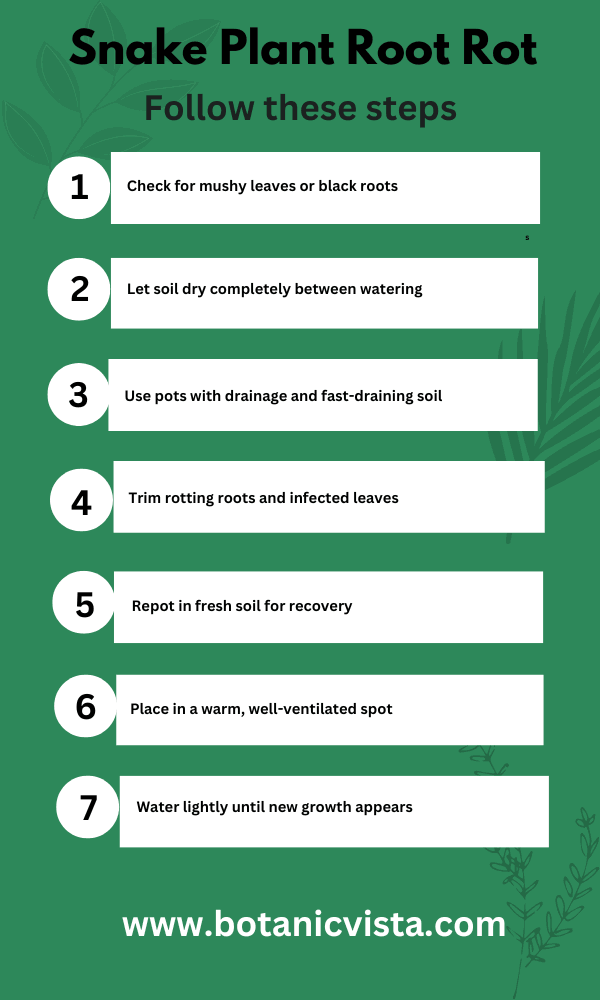Last Updated on October 14, 2024 by Jocelyn
Snake plants are loved for their dark green, stiff leaves and are a favorite among indoor gardeners for their low maintenance and striking look.
These evergreen plants, part of the Asparagaceae family, can grow several centimeters tall. However, despite their tough nature, they can still face problems like root rot.
Root rot is a serious issue that begins underground, affecting the creeping rhizome and spreading to the mature leaves above ground. This problem often occurs when the plant is overwatered.
The excess water leads to poor oxygen exchange, creating an environment where harmful fungi can spread. If not treated quickly, root rot can cause permanent damage to your plant.
In this article, we will cover the signs, causes, treatment, and preventive tips for root rot. These insights will help you protect your snake plant and keep it healthy.

Table of Contents
ToggleIdentifying Root Rot in Snake Plants
If not caught early, root rot can lead to a smelly mess. It often starts with yellowing leaves and weak, wobbly stems that seem sickly. As you inspect the roots and soil, you may find them becoming discolored and soft, squishy. These are clear indicators that your plant is suffering from root damage.
Let’s discuss the common signs of root rot.
1. Mushy and Soft Leaves
When the leaves of your snake plant feel mushy and soft, it’s a clear clue that something is wrong. This symptom often indicates that the roots are waterlogged and struggling to stay healthy.
2. Snake Plant Wilting Leaves
Wilting leaves are a distress signal from your snake plant. This could be due to underwatering, low humidity, or poor drainage. These issues can cause damage that needs to be addressed quickly.
3. Yellowing and Softening Leaves
As root issues progress, under- and overwatering or nutrient deficiency can cause the blades of the snake plant to turn yellow and become soft. This change in appearance signals that the rot has advanced and needs immediate attention.
4. Mushy Black Roots
Upon inspecting the roots, finding mushy black roots is a serious warning sign. Healthy roots should be firm and strong, but these have turned into a crime scene of rot.
Major Causes of Snake Plant Root Rot
Snake plants are popular, but root rot can be a significant problem. Overwatering and poor drainage are the main causes, leading to moisture buildup in the soil. If the plant sits in saturated soil, the roots may start to rot, causing sluggish growth and a smelly crown.
Overwatering and Poor Drainage
Root rot can occur when plants are overwatered or planted in soil with poor drainage. Excess moisture can suffocate roots, hindering their ability to absorb nutrients and water. Compacted soil and large pots can make the problem worse by trapping stagnant water.
Incorrect Pot Size and Soil Issues
Using the incorrect pot size can cause restricted roots and insufficient root space. This leads to nutrient deficiency and reduced growth. Tight soil and inadequate oxygen levels also contribute to root rot, especially if the soil becomes waterlogged.
Temperature and Humidity Problems
These factors can slow down the plant’s growth. Dormant fungi can become active in such conditions, leading to root rot. Keeping the plant in a dry environment with proper ventilation helps in preventing moisture retention.
Treating Root Rot in Snake Plant
Sometimes, root rot can occur if the soil stays too wet. This can make the roots mushy and smelly, and the plant may stop growing. If you notice these signs, it’s important to act quickly to save your plant. Below are simple steps to help your snake plant recover and grow strong again.
1. Spotting the Problem
Check for mushy or smelly roots. This is a clear sign of root rot. The leaves may start to shrivel and turn yellow. Root rot happens when there’s too much moisture in the soil.
2. Preparing for Treatment
First, carefully remove the plant from the plastic pot. Shake off the soil to see the roots. Use garden sheers to trim away the damaged, mushy parts. Make sure to sanitize the tools using hydrogen peroxide to avoid spreading the fungus. If the roots are badly affected, you might need to cut off more than you think.
3. Cleaning and Pruning
Rinse the healthy roots with water mixed with a bit of vinegar solution. This helps clean away any remaining fungus. After cleaning, let the roots dry to form a callus. This natural remedy helps protect the plantlet from more damage.
4. Repotting the Plant
Choose a clean plastic pot with good drainage. Fill it with fresh, fast-draining substrate mixed with perlite to avoid waterlogging. Place the plantlet back in the pot and lightly fill the rest with the substrate. Make sure there are no air pockets around the roots.
5. Providing the Right Environment
Put the replanted snake plant in a bright area with indirect sunlight. Water it sparingly to avoid more moisture problems. Over the recovery period, check for new leaves or a sprout as signs of adaptation and recovery.
6. Nurturing and Ongoing Care
Keep an eye on the plant and ensure it’s in a light but indirect sunlight spot. If you see fungal infection returning, a gentle fungicide spray might be necessary. With proper care, your snake plant will get a fresh start and grow healthy again.
Preventing Root Rot
Snake plants are a favorite because they are tough and easy to care for. Their unique structure and adaptability allow them to thrive in various conditions. However, understanding the best practices for their care is essential to ensure they grow strong and remain healthy.
Here’s a simple guide to preventive care that will help you avoid root rot and keep your snake plant flourishing.
| Preventive Measure | Details |
| Watering | Water every 2-3 weeks; let soil dry between waterings. |
| Soil and Potting | Use well-draining soil and a pot with drainage holes; avoid oversized pots. |
| Repotting | Repot every 2-3 years in spring; use fresh soil. |
| Fertilization | Fertilize lightly in spring and summer with balanced, low-nitrogen fertilizer. |
| Pest Control | Clean leaves regularly to prevent pests like spider mites. |
| Lighting & Temperature | Keep in bright, indirect light and maintain a room temperature of 60-85°F. |
FAQ’s
Q: How Do You Revive a Snake Plant?
A: To revive a snake plant with root rot, start by trimming the damaged roots and tossing the old soil. Let the roots air dry for a few days. Afterward, replace the soil with a new mix, and replant the snake plant in a dry pot. Water lightly and keep the leaves dry.
Q: How Long Does Root Rot Take To Fix?
A: Root rot typically takes about 2 weeks to fix with proper care. During this period, your plant can start to bounce back and show signs of becoming healthy again.
Q: What Does a Sick Snake Plant Look Like?
A: A sick Snake Plant often shows yellowing leaves, flopping foliage, and strange residues. You may also notice slow growth or marks on the leaves, along with signs of pest infestations like eggs and larvae, indicating something is not right.
Q: Should I Mist My Snake Plant?
A: No, you should not mist your snake plant. Spraying water on the leaves can lead to rot at the base of the leaf rosettes.
Q: How to Fix Root Rot Without Repotting?
A: Trim the rotting roots with sterilized scissors and rinse them under running water. Prune any damaged foliage, and ensure the soil is dry before watering lightly to help the plant recover.
Q: How Long Do Snake Plants Live?
A: With proper care, snake plants can easily live 10 to 25 years. Their resilience, like other succulents such as aloe and cactus, allows them to have a long lifespan.
Conclusion
Root rot can be a serious issue for your snake plant. Overwatering often leads to soft roots and a weakened plant. To prevent this, use a pot with good drainage and check the soil’s moisture regularly. These steps will help your snake plant stay healthy and strong. Ready to apply these tips? Start refining your care routine today!

